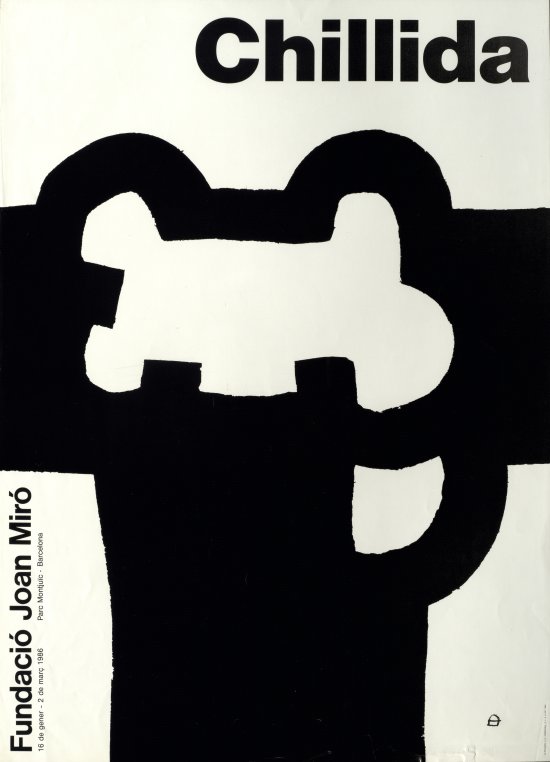- Dates
- —
Chillida: Sculptures
Second press release
Exhibition from 16 January
Chillida (1951-1985)
The Fundació Joan Miró will open an exhibition by the Basque sculptor Eduardo Chillida on 16 January. A total of forty-six works in various materials – iron, concrete, alabaster and clay – are featured in the exhibition of this great artist, who has a well-deserved international reputation.
The selection on display in our city ranges from his first iron sculpture, Ilarik, from 1951, to those he completed as recently as 1985. Most of the works were exhibited in the Europalia’85 exhibition at the Palais des Beaux-Arts in Brussels.
The large number of works in this exhibition and their singularity make up a collection that is fully representative of Eduardo Chillida’s constant research and creativity over the past thirty-five years, an artist whose personality and importance place him in an eminent position within contemporary art. He is rightly one of the most internationally acclaimed contemporary sculptors, receiving everything from the Honorary Prize of the Milan Triennale (1954) or the Venice Biennale (1958) and Rembrandt (1975) Prizes, and most recently the Wolf Foundation Prize in Tel Aviv, Israel (1985), the first to be awarded for the work of a sculptor.
The exhibition, which can be considered one of the most comprehensive, includes Ilarik (1951), Anvil of Dreams IX (1959) – in iron and wood – Modulation of Space I (1963), Homage to Architecture II (1972), Gudari (1974-1975), How Profound Is the Air (a tribute to Jorge Guillén, 1983) – the latter works in steel – Mendi Huts (Empty Mountain, 1984) – in alabaster – and Lurra (Earth, 1985) – in clay – to name but a few. The pieces come in a variety of sizes, both large and small, and many of them are formed by a large solid mass weighing between two and three tonnes, and in some spectacular cases reaching up to 7,000 kilos.
One of the most captivating aspects of Chillida’s work that visitors notice when they see them is the quality of their attractiveness, the suggestiveness and stimulation of new questions that seeing the work compels them to ask. Chillida is an artist of inexhaustible creative abundance, capable of guiding his work along a path of constant discovery, full of sensations and ideas materialised with craft precision. The essential core of his works is space: point of departure and origin as well as limits. ‘Limits are the real protagonists of space, just as the present, another limit, is the real protagonist of time,’ claims the sculptor.
Chillida’s sculptures are manifestations of a reality that stems from this element, space, which in his work assumes a dual aspect: on the one hand, space defined outside sculptural mass – exterior space – on the other hand, what he calls ‘interior space’, of equal or even greater force, bounded by the very material of which the work is made. ‘Interior space, both the consequence and the origin of positive exterior volumes,’ he explains. Interior space is energy trapped in every form. Some of the most basic concepts of material human existence can be found in this manner of dealing with space, in its plastic and philosophical notions: mass/empty space, up/down, inward/outward, etc. Chillida is characterised by his strong and intense rational meditation on the phenomena of existence, expressed with great clarity through their materialisation in sculptural works. He establishes a dialogue, or rather a language of forms. But we must not forget his approach to materials: his use of iron, wood, marble, alabaster and clay, as well as the extreme craft professionalism with which he works when it comes to smelting and hammering iron, bending and twisting solid steel, or cutting, drilling and polishing wood.
Chillida has found a third way in sculpture, a combination of the classicism of mass sculpture in human form and the construction of non-figurative volumes that can be based on mathematics. His is a rational language with matter, charged with force and energy, as well as with spiritual contents such as space, light, air, wind, music and existence.
Set to open on 16 January at 7.30 pm, the exhibition will run at the Fundació Joan Miró until 2 March. A complementary activity in the form of a screening of Laurence Boulting’s film Chillida at Home: A Portrait (in its English version) will accompany the exhibition for any interested individuals or groups (by prior appointment).
Barcelona, 9 January 1986


